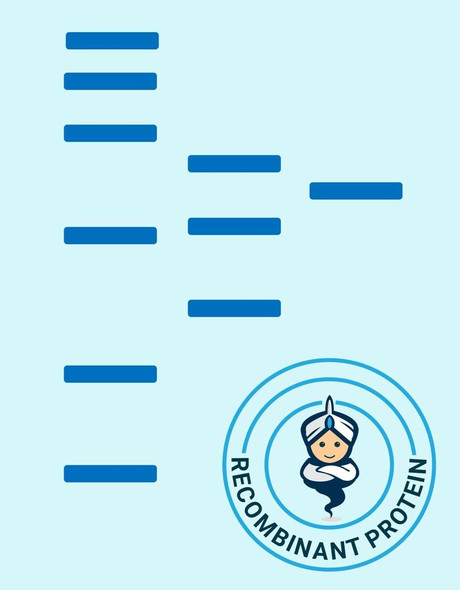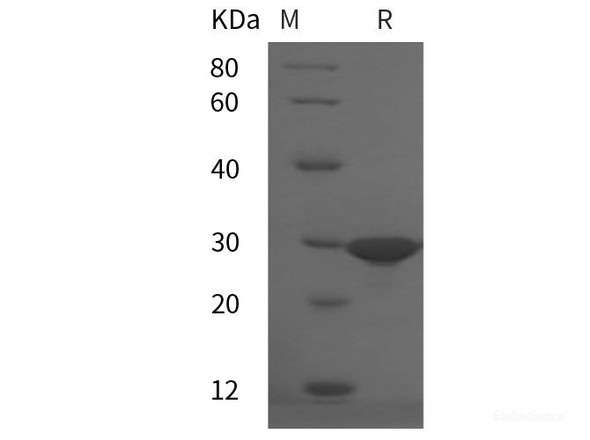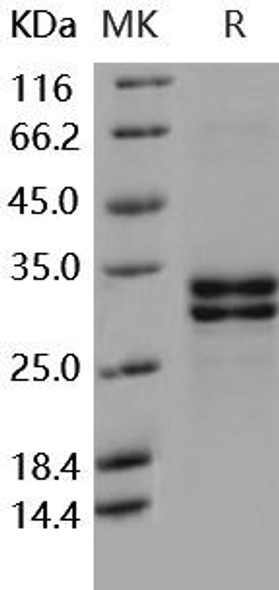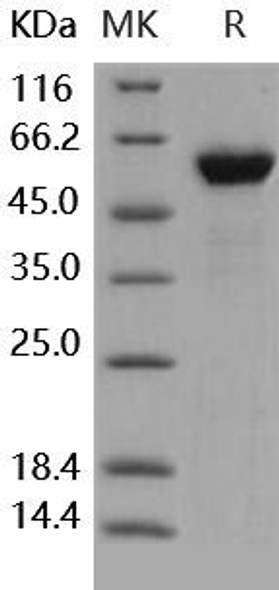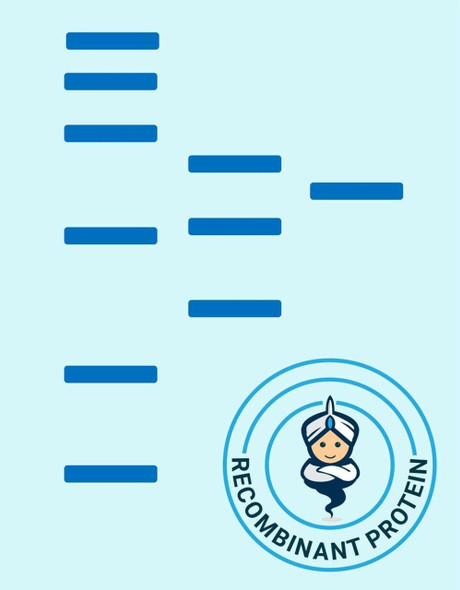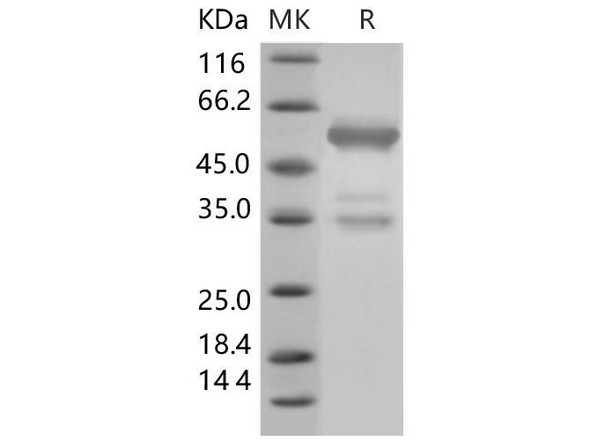Description
| Product Name: | Human HMGB1 Recombinant Protein |
| Product Code: | RPPB3697 |
| Size: | 50µg |
| Species: | Human |
| Target: | HMGB1 |
| Synonyms: | HMG1, HMG3, SBP-1, Amphoterin, HMGB1, High-Mobility Group Box 1. |
| Source: | Escherichia Coli |
| Physical Appearance: | Sterile Filtered White lyophilized (freeze-dried) powder. |
| Formulation: | The HMG1 (1mg/ml) was lyophilized after extensive dialyses against 1x PBS pH-7.4. |
| Solubility: | It is recommended to reconstitute the lyophilized HMGB1 in sterile 18M?-cm H2O not less than 100 �g/ml, which can then be further diluted to other aqueous solutions. |
| Stability: | Lyophilized HMGB1 although stable at room temperature for 3 weeks, should be stored desiccated below -18°C. Upon reconstitution HMGB1 should be stored at 4°C between 2-7 days and for future use below -18°C.For long term storage it is recommended to add a carrier protein (0.1% HSA or BSA).Please prevent freeze-thaw cycles. |
| Purity: | Greater than 95.0% as determined by:(a) Analysis by RP-HPLC.(b) Analysis by SDS-PAGE. |
| Amino Acid Sequence: | MGKGDPKKPRGKMSSYAFFVQTCREEHKKKHPDASVNFSEFSKKCSERWKTMSAKEKGKFEDMAKADKARYEREMKTYIPPKGETKKKFKDPNAPKRPPSAFFLFCSEYRPKIKGEHPGLSIGDVAKKLGEMWNNTAADDKQPYEKKAAKLKEKYEKDIAAYRAKGKPDAAKKGVVKAEKSKKKKEEEEDEEDEEDEEEEEDEEDEDEEEDDDDELEHHHHHH |
High-mobility group box 1 protein (HMGB1), previously known as HMG-1 or amphoterin, is a member of the high mobility group box family of non-histone chromosomal proteins. Human HMGB1 is expressed as a 30 kDa, 215 amino acid (aa) single chain polypeptide containing three domains: two N-terminal globular, 70 aa positively charged DNA-binding domains (HMG boxes A and B), and a negatively charged 30 aa C-terminal region that contains only Asp and Glu.4, 5 Residues 27 - 43 and 178 - 184 contain a NLS. Posttranslational modifications of the molecule have been reported, with acetylation occurring on as many as 17 lysine residues. HMGB1 is expressed at high levels in almost all cells. It was originally discovered as a nuclear protein that could bend DNA. Such bending stabilizes nucleosome formation and regulates the expression of select genes upon recruitment by DNA binding proteins.
HMG1 Human Recombinant fused with 6X His tag produced in E.Coli is a single, non-glycosylated, polypeptide chain containing 223 amino acids and having a molecular mass of 26 kDa.The HMGB-1 is purified by proprietary chromatographic techniques.
| UniProt Protein Function: | Multifunctional redox sensitive protein with various roles in different cellular compartments. In the nucleus is one of the major chromatin-associated non-histone proteins and acts as a DNA chaperone involved in replication, transcription, chromatin remodeling, V(D)J recombination, DNA repair and genome stability. Proposed to be an universal biosensor for nucleic acids. Promotes host inflammatory response to sterile and infectious signals and is involved in the coordination and integration of innate and adaptive immune responses. In the cytoplasm functions as sensor and/or chaperone for immunogenic nucleic acids implicating the activation of TLR9-mediated immune responses, and mediates autophagy. Acts as danger associated molecular pattern (DAMP) molecule that amplifies immune responses during tissue injury (PubMed:27362237). Released to the extracellular environment can bind DNA, nucleosomes, IL-1 beta, CXCL12, AGER isoform 2/sRAGE, lipopolysaccharide (LPS) and lipoteichoic acid (LTA), and activates cells through engagement of multiple surface receptors. In the extracellular compartment fully reduced HMGB1 (released by necrosis) acts as a chemokine, disulfide HMGB1 (actively secreted) as a cytokine, and sulfonyl HMGB1 (released from apoptotic cells) promotes immunological tolerance (PubMed:23519706, PubMed:23446148, PubMed:23994764, PubMed:25048472). Has proangiogdenic activity. May be involved in platelet activation. Binds to phosphatidylserine and phosphatidylethanolamide. Bound to RAGE mediates signaling for neuronal outgrowth. May play a role in accumulation of expanded polyglutamine (polyQ) proteins such as huntingtin (HTT) or TBP (PubMed:23303669, PubMed:25549101). |
| NCBI Summary: | This gene encodes a protein that belongs to the High Mobility Group-box superfamily. The encoded non-histone, nuclear DNA-binding protein regulates transcription, and is involved in organization of DNA. This protein plays a role in several cellular processes, including inflammation, cell differentiation and tumor cell migration. Multiple pseudogenes of this gene have been identified. Alternative splicing results in multiple transcript variants that encode the same protein. [provided by RefSeq, Sep 2015] |
| UniProt Code: | P09429 |
| NCBI GenInfo Identifier: | 123369 |
| NCBI Gene ID: | 3146 |
| NCBI Accession: | P09429.3 |
| UniProt Secondary Accession: | P09429,Q14321, Q5T7C3, Q6IBE1, A5D8W9, |
| UniProt Related Accession: | P09429 |
| Molecular Weight: | 24,894 Da |
| NCBI Full Name: | High mobility group protein B1 |
| NCBI Synonym Full Names: | high mobility group box 1 |
| NCBI Official Symbol: | HMGB1�� |
| NCBI Official Synonym Symbols: | HMG1; HMG3; HMG-1; SBP-1�� |
| NCBI Protein Information: | high mobility group protein B1 |
| UniProt Protein Name: | High mobility group protein B1 |
| UniProt Synonym Protein Names: | High mobility group protein 1; HMG-1 |
| Protein Family: | High mobility group protein |
| UniProt Gene Name: | HMGB1�� |



